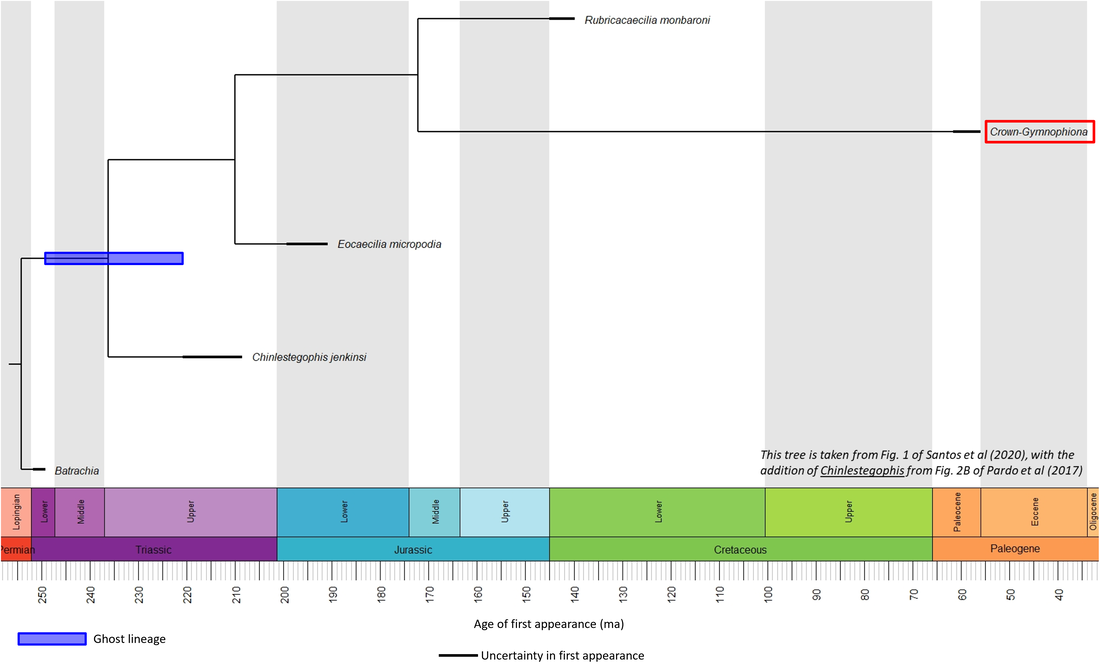The caecilians (order Gymnophiona, class Amphibia) are limbless amphibians that generally live either in the soil or in water, and superficially resemble earthworms or eels. About 180 living species are known, divided into 10 families.
The phylogeny of the stem-Gymphiona, based on the few known fossils, is illustrated in the time tree below:
The phylogeny of the stem-Gymphiona, based on the few known fossils, is illustrated in the time tree below:
Figure 1. Time tree of the stem-Gymnophiona
The oldest known member of the stem group is Chinlestegophis jenkinsi, from the Late Triassic (Middle - Late Norian) Chinle Formation at the Main Elk Creek locality, Garfield County, Colorado, USA (Pardo et al, 2017). However, it should be noted that the interpretation of Chinlestegophis as a stem-Gymnophiona is questioned by Santos et al (2020). No public-domain images of this species are available, but the other two known stem caelicians are illustrated below (click on image for larger version):
Figure 2. Images of stem-Gymnophiona
With images of only two stem species it is not possible to discern any trend, but it is noteworthy that the two stem-group fossils restored above have small limbs, in contrast to the modern caecilians (however, no limbs were found for the fossil of Chinlestegophis jenkinsi, which comprises only a partial skull).
The earliest known fossil representative of crown-group Gymnophiona is Apodops pricei, found in a Late Paleocene fissure fill in the limestone quarry of the Companhia National de Cimento Portland, Rio de Janeiro, Brazil (Estes and Wake, 1972; Benton et al, 2015). Unfortunately, no images of this fossil are available in the public domain.
The caecilian stem line includes a ghost lineage (shown as a blue bar in Figure 1), because the oldest known total-group batrachian (of Early Triassic age; see page on the Batrachia) is at least 28 million years older than the stem-group caecilians, which are of Late Triassic and younger age. Given that the two stem groups must have appeared at the same time, the caecilian stem-group transition must also have begun in the Early Triassic. This implies a stem-to-crown transition of at least 188 million years.
The earliest known fossil representative of crown-group Gymnophiona is Apodops pricei, found in a Late Paleocene fissure fill in the limestone quarry of the Companhia National de Cimento Portland, Rio de Janeiro, Brazil (Estes and Wake, 1972; Benton et al, 2015). Unfortunately, no images of this fossil are available in the public domain.
The caecilian stem line includes a ghost lineage (shown as a blue bar in Figure 1), because the oldest known total-group batrachian (of Early Triassic age; see page on the Batrachia) is at least 28 million years older than the stem-group caecilians, which are of Late Triassic and younger age. Given that the two stem groups must have appeared at the same time, the caecilian stem-group transition must also have begun in the Early Triassic. This implies a stem-to-crown transition of at least 188 million years.
References
Benton, M. J., Donoghue, P. C., Asher, R. J., Friedman, M., Near, T. J., & Vinther, J. (2015). Constraints on the timescale of animal evolutionary history. Palaeontologia Electronica, 18(1), 1-106.
Estes, R., & Wake, M. H. (1972). The first fossil record of caecilian amphibians. Nature, 239(5369), 228-231.
Frost, D. R., Grant, T., Faivovich, J., Bain, R. H., Haas, A., Haddad, C. F., ... & Wheeler, W. C. (2006). The amphibian tree of life. Bulletin of the American Museum of natural History, 2006(297), 1-291.
Pardo, J. D., Small, B. J., & Huttenlocker, A. K. (2017). Stem caecilian from the Triassic of Colorado sheds light on the origins of Lissamphibia. Proceedings of the National Academy of Sciences, 114(27), E5389-E5395.
Santos, R. O., Laurin, M., & Zaher, H. (2020). A review of the fossil record of caecilians (Lissamphibia: Gymnophionomorpha) with comments on its use to calibrate molecular timetrees. Biological Journal of the Linnean Society, 131(4), 737-755.
Estes, R., & Wake, M. H. (1972). The first fossil record of caecilian amphibians. Nature, 239(5369), 228-231.
Frost, D. R., Grant, T., Faivovich, J., Bain, R. H., Haas, A., Haddad, C. F., ... & Wheeler, W. C. (2006). The amphibian tree of life. Bulletin of the American Museum of natural History, 2006(297), 1-291.
Pardo, J. D., Small, B. J., & Huttenlocker, A. K. (2017). Stem caecilian from the Triassic of Colorado sheds light on the origins of Lissamphibia. Proceedings of the National Academy of Sciences, 114(27), E5389-E5395.
Santos, R. O., Laurin, M., & Zaher, H. (2020). A review of the fossil record of caecilians (Lissamphibia: Gymnophionomorpha) with comments on its use to calibrate molecular timetrees. Biological Journal of the Linnean Society, 131(4), 737-755.
Image credits - Stem-Gymnophiona
- Header (Caecilian (Caecilia subnigricans) photographed in the Magdalena Valley, Colombia): José Gabriel Julio Guzmán, CC BY 4.0 <https://creativecommons.org/licenses/by/4.0>, via Wikimedia Commons
- Figure 2 (braincase of Eocaecilia macropodia): Hillary C. Maddin, Farish A. Jenkins Jr, Jason S. Anderson, CC BY 2.5 <https://creativecommons.org/licenses/by/2.5>, via Wikimedia Commons
- Figure 2 (Eocaecilia macropodia, life restoration): Nobu Tamura under a Creative Commons 3.0 Unported (CC BY-NC-ND 3.0) license
- Figure 2 (partial lower jawbone of Rubricacaecilia monbaroni): Roberto Díaz Sibaja, CC BY-SA 4.0 <https://creativecommons.org/licenses/by-sa/4.0>, via Wikimedia Commons
- Figure 2 (Rubricacaecilia monbaroni, life restoration): Levi Bernardo Martínez, CC0, via Wikimedia Commons




